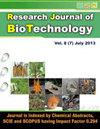Molecular characterization of Marek's disease virus revealing the predominance of high-virulence MDV in Vietnam
IF 0.2
Q4 Biochemistry, Genetics and Molecular Biology
引用次数: 0
Abstract
Marek's disease (MD) is a potentially fatal viral disease caused by the Gallid alphaherpesvirus 2 (GaHV-2). The outbreaks are common in both unprotected and vaccinated flocks. The carcinogenic serotype MDV-1 was found using a PCR method in five northern provinces and two central provinces of Vietnam from 2019 to 2022. The Meq gene from 13 MDV-1 strains was sequenced in its entirety, containing 1020 nucleotides encoding 339 amino acids. The examination of these genomes revealed that all strains discovered in Vietnam correspond to the pathotypes known as highly virulent (vv). This classification was based on the presence of low proline concentration (from 20.59-21.18%) in the Meq which consisted of three PPPP motifs and three interrupted motifs. The interrupted motifs are characterized by mutations at the second position of the proline-rich region where the original PPPP sequence is altered to PPPP>P (Q / A / R) PP. Furthermore, the Vietnamese GaHV-2 strains in this study had the most similarity to high-virulence Chinese strains but had the lowest similarity to the currently used CVI988 vaccination. It is worth noting that no strains from the moderate pathogenicity (mv) or very virulence plus (vv+) groups were found among the Vietnamese isolates. The findings shed light on previously unknown molecular features of Marek's disease virus strains in Vietnam's northern provinces. The study's findings add to a better understanding of MDV in Vietnam, filling an important information gap. This knowledge can help guide efforts to reduce the burden of Marek's disease on the chicken business, improve disease prevention and control strategies and select the best vaccine for chickens in the field.马立克病病毒的分子特征揭示了越南高毒力MDV的优势
马雷克病(MD)是一种由Gallid alphaherpesvirus 2 (GaHV-2)引起的潜在致命性病毒性疾病。疫情在未受保护和接种疫苗的鸡群中都很常见。2019 - 2022年在越南北部5个省和中部2个省检测到致癌性血清型MDV-1。对13株MDV-1株的Meq基因进行了全序列测序,共包含1020个核苷酸,编码339个氨基酸。对这些基因组的检测显示,在越南发现的所有菌株都对应于高毒型(vv)。这种分类基于Meq中存在低脯氨酸浓度(20.59-21.18%),该Meq由三个PPPP基序和三个中断基序组成。中断基序的特征是在脯氨酸富集区第2位发生突变,原PPPP序列改变为PPPP>P (Q / A / R) PP。此外,本研究中越南GaHV-2毒株与高毒力中国毒株的相似性最大,而与目前使用的CVI988疫苗的相似性最低。值得注意的是,在越南分离株中未发现中等致病性(mv)或非常毒力+ (vv+)群的菌株。这一发现揭示了越南北部省份马立克病病毒株以前未知的分子特征。这项研究的发现有助于更好地了解越南的MDV,填补了一个重要的信息空白。这些知识可以帮助指导减少马立克氏病对鸡业的负担,改进疾病预防和控制策略,并为鸡选择最佳疫苗。
本文章由计算机程序翻译,如有差异,请以英文原文为准。
求助全文
约1分钟内获得全文
求助全文
来源期刊

Research Journal of Biotechnology
工程技术-生物工程与应用微生物
CiteScore
0.60
自引率
0.00%
发文量
192
审稿时长
1.5 months
期刊介绍:
We invite you to contribute Research Papers / Short Communications / Review Papers:
-In any field of Biotechnology, Biochemistry, Microbiology and Industrial Microbiology, Soil Technology, Agriculture Biotechnology.
-in any field related to Food Biotechnology, Nutrition Biotechnology, Genetic Engineering and Commercial Biotechnology.
-in any field of Biotechnology related to Drugs and Pharmaceutical products for human beings, animals and plants.
-in any field related to Environmental Biotechnolgy, Waste Treatment of Liquids, Soilds and Gases; Sustainability.
-in inter-realted field of Chemical Sciences, Biological Sciences, Environmental Sciences and Life Sciences.
-in any field related to Biotechnological Engineering, Industrial Biotechnology and Instrumentation.
-in any field related to Nano-technology.
-in any field related to Plant Biotechnology.
 求助内容:
求助内容: 应助结果提醒方式:
应助结果提醒方式:


